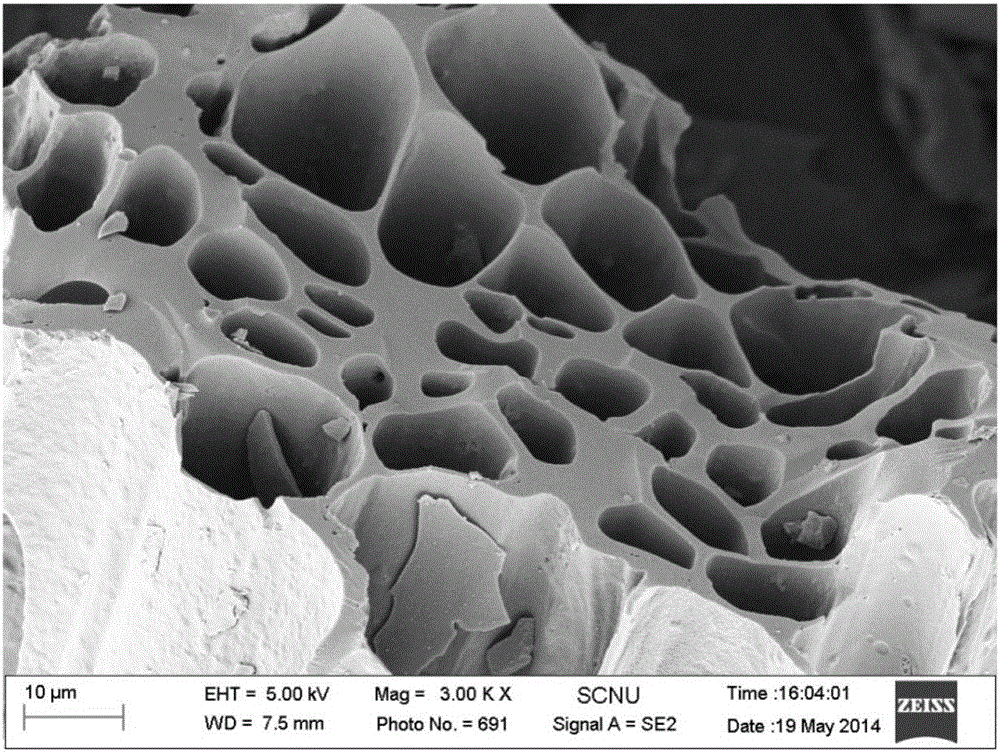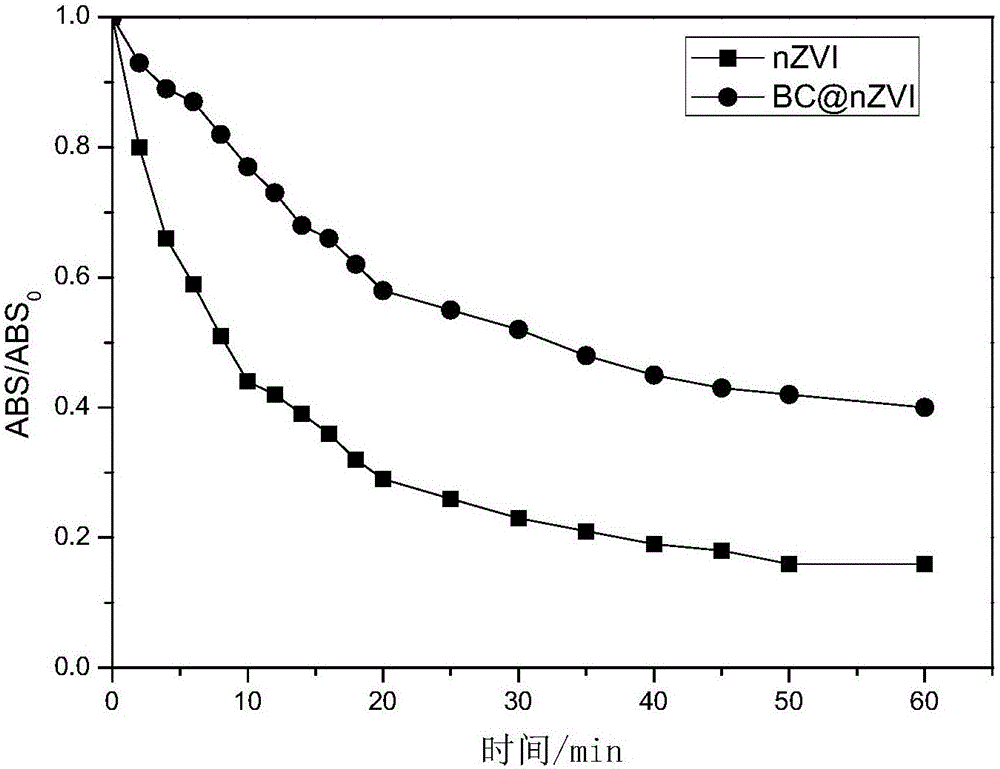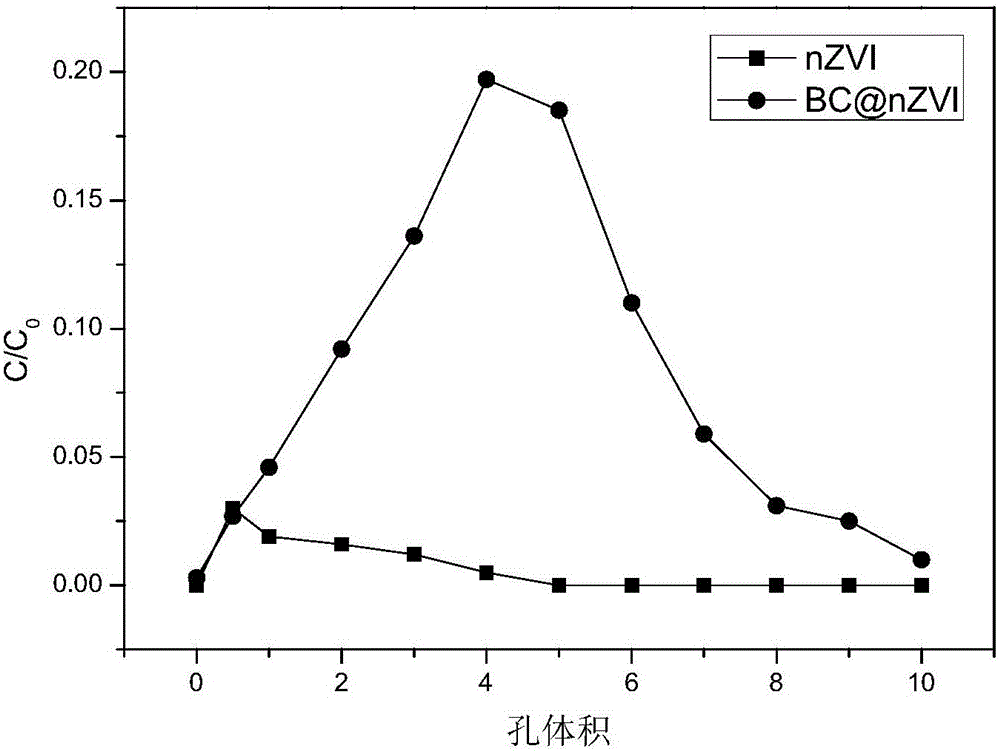Preparation and application for heavy metal chromium contaminated soil remediation material
A granular and biochar technology, which is applied in the restoration of polluted soil, soil conditioning materials, applications, etc., can solve the problem of poor flow performance and stability of materials, unfavorable soil reuse and plant regrowth, and reduce the effect of materials on chromium repair, etc. problems, to achieve the effects of good stability and fluidity, easy promotion and use, and convenient operation
- Summary
- Abstract
- Description
- Claims
- Application Information
AI Technical Summary
Problems solved by technology
Method used
Image
Examples
preparation example Construction
[0038] A preparation method of biochar particles, the steps are:
[0039] 1) Wash, dry and crush the agricultural waste to obtain substance A;
[0040] 2) Substance A is deoxidized and carbonized under a protective atmosphere, and the carbonized product is ground and sieved to obtain biochar particles.
[0041] Preferably, the agricultural waste is bagasse.
[0042] Preferably, step 2) is specifically: put substance A into a crucible, place it in a muffle furnace with a protective atmosphere, and raise the temperature of the muffle furnace to 500-700°C at a heating rate of 15-25°C / min to reach the temperature After the interval, keep at this temperature for 1-3 hours to fully deoxidize and carbonize, then cool down to room temperature in the muffle furnace, take out the black residue, grind and sieve to obtain biochar particles;
[0043] More preferably, the number of meshes used for the above-mentioned sieving is 24 mesh to 200 mesh, more preferably, 60 mesh to 120 mesh;
...
Embodiment 1
[0062] Preparation of biochar particles with different particle sizes:
[0063] 1) Wash the bagasse, air-dry it, and cut it into sugarcane pieces of 1cm×1cm×1cm;
[0064] 2) Put the treated sugarcane block into the crucible, then put it in the muffle furnace, under the protection of nitrogen, deoxidize carbonization at the set temperature of 600°C, and continue to Carbonize for 2 hours. After the temperature of the muffle furnace drops to room temperature, take out the black residue, grind it, and sieve it (the mesh size of the sieve is 24 mesh to 200 mesh) to obtain biochar particles with different particle sizes (the particle size is 0.701mm~ 0.074 mm), the biochar particles with better stability were selected through sedimentation experiments.
[0065] figure 1 It is a scanning electron microscope (SEM) picture of the biochar particles prepared in this example;
Embodiment 2
[0067] Preparation of supported nanometer zero-valent iron particles in different proportions:
[0068] 1) Prepare 100ml of 0.1mol / L FeSO with ethanol and water (V:V=3:7) 4 ·7H 2 O solution, stirred at a speed of 400rpm for 10min to dissolve and mix to obtain solution A;
[0069] 2) Add biochar particles with better stability (Example 1) into solution A, stir at a speed of 500rpm for 60min, dissolve and mix well, and obtain solution B;
[0070] 3) Prepare 50ml of 0.3mol / L sodium borohydride solution with ethanol and water (V:V=3:7), quickly add it to solution B under the protection of nitrogen, and continue stirring at a speed of 500rpm React for 30 minutes, then separate nanometer zero valent iron by magnetic separation, wash with deoxygenated water, absolute ethanol and acetone respectively, after each washing twice, vacuum dry at 50°C to 60°C to prepare loaded nanometer zero Valence iron particles.
[0071] 4) According to the above method, prepare biochar-nano-zero-val...
PUM
| Property | Measurement | Unit |
|---|---|---|
| particle diameter | aaaaa | aaaaa |
Abstract
Description
Claims
Application Information
 Login to View More
Login to View More - R&D
- Intellectual Property
- Life Sciences
- Materials
- Tech Scout
- Unparalleled Data Quality
- Higher Quality Content
- 60% Fewer Hallucinations
Browse by: Latest US Patents, China's latest patents, Technical Efficacy Thesaurus, Application Domain, Technology Topic, Popular Technical Reports.
© 2025 PatSnap. All rights reserved.Legal|Privacy policy|Modern Slavery Act Transparency Statement|Sitemap|About US| Contact US: help@patsnap.com



